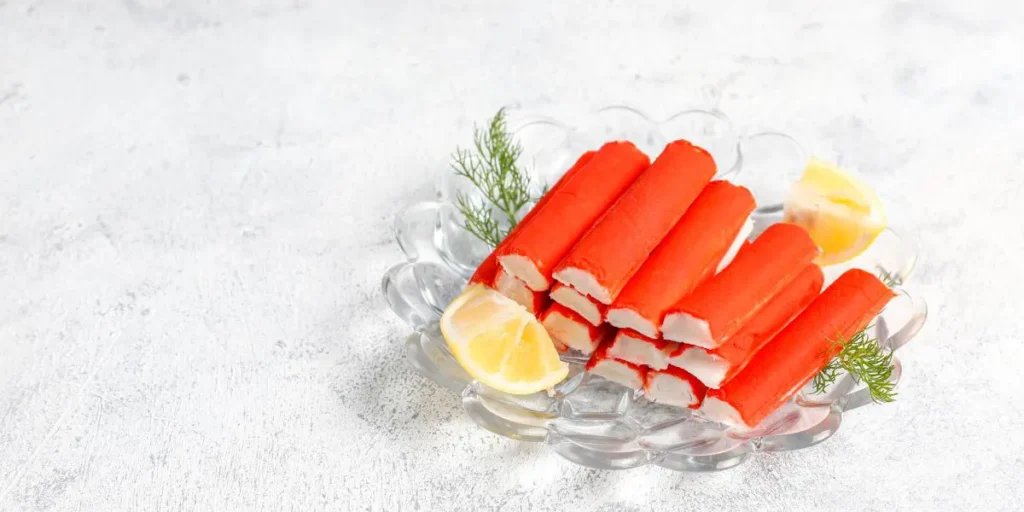Introduction to Imitation Crab Meat
Are you curious about what is the best way to eat imitation crab meat? This comprehensive guide delves into the world of imitation crab, offering insights into selecting, preparing, and savoring this versatile seafood alternative. From creative recipes to nutritional advice, we cover everything you need to know to enjoy imitation crab meat at its best.
Discovering the Best Ways to Enjoy Imitation Crab
Imitation crab, a culinary innovation, has revolutionized the seafood industry. Crafted from surimi, a fish paste typically made from pollock or other white fish, it undergoes a transformation to mimic the taste and texture of real crab meat. This product, known for its affordability and versatility, has become a staple in various cuisines around the globe.
Popularity and Versatility
The ascent of imitation crab in the culinary world is a testament to its versatility and appeal. It’s an ingredient that seamlessly adapts to a myriad of dishes, from salads and appetizers to main courses. Whether it’s incorporated into a California sushi roll, mixed into a creamy pasta, or simply enjoyed as a snack, imitation crab proves to be a versatile and budget-friendly alternative to traditional seafood.
The Art of Imitation
Understanding the process behind imitation crab is key to appreciating its unique qualities. Surimi, the base ingredient, is finely minced and flavored to resemble the delicate flavor of crab. This process not only makes it a cost-effective option but also allows it to be used in a variety of culinary applications where real crab may not be feasible.
Culinary Applications
Imitation crab opens up a world of culinary possibilities. It’s a popular choice in Asian cuisines, particularly in Japanese dishes like sushi and salads. In Western cuisine, it finds its way into crab cakes, dips, and even as a filling for sandwiches and wraps. Its ability to absorb and complement different flavors makes it a favorite among home cooks and professional chefs alike.
In the next section, we delve into the nuances of selecting and preparing imitation crab, ensuring you get the best out of this unique ingredient. Stay tuned as we explore the art of working with imitation crab meat, a journey that promises to be both informative and delicious.
Selecting and Preparing Imitation Crab Meat
In this part, we focus on answering the question: What is the best way to eat imitation crab meat in terms of selection and preparation? Choosing the right product is crucial for the best culinary experience. We will guide you through selecting quality imitation crab and share essential preparation techniques.
Choosing Quality Imitation Crab for Optimal Enjoyment
Selecting the right imitation crab is essential for the success of your dishes. Here’s how to ensure you pick the best:
- Read the Ingredients: A shorter ingredient list usually indicates a higher-quality product. Look for brands that use real fish as the primary ingredient and avoid those with a long list of additives.
- Check the Texture and Color: High-quality imitation crab should have a texture that’s firm yet slightly flaky, similar to real crab. The color should be subtly pinkish, resembling cooked crab meat.
- Freshness Matters: Always check the expiration date. A fresh product will have a mild, sea-like scent without any fishy or off odors.
Mastering Preparation: Key to Best Eating Imitation Crab Meat
Proper preparation is crucial to bring out the best in imitation crab. Here are some tips:
- Thawing and Handling: If frozen, thaw it in the refrigerator overnight. Avoid using high heat or microwave as it can change the texture.
- Cooking and Incorporating: Remember, imitation crab is already cooked, so it’s more about incorporating it into your dishes. It can be added to both hot and cold recipes. For hot dishes, add it towards the end of the cooking process to avoid overcooking. In cold dishes like salads, it can be used straight from the package.
Creative Cooking Ideas
Imitation crab’s versatility makes it a fantastic ingredient for various culinary creations:
- In Salads and Cold Dishes: Its light, flaky texture is perfect for cold dishes. Mix it with fresh greens, avocado, and a tangy dressing for a delightful salad. It’s also great in cold pasta salads or as a topping for crackers.
- As a Filling and Ingredient: Use it as a filling in wraps, sandwiches, or sushi rolls. Its mild flavor pairs well with a variety of ingredients, offering a delightful seafood taste. It’s also a great addition to omelets or quiches.
- In Hot Dishes: Imitation crab adds a unique flavor to hot dishes. Try it in pasta dishes, like a creamy Alfredo or a spicy arrabbiata. It’s also great in soups, stews, and chowders, where it can absorb the flavors of the broth.
In the next part, we’ll explore an array of creative recipes that showcase the versatility of imitation crab. From simple appetizers to hearty main courses, these recipes will inspire you to incorporate this unique ingredient into your cooking repertoire.
Creative Recipes with Imitation Crab
Continuing our exploration of what is the best way to eat imitation crab meat, this section introduces creative recipes. From appetizers to main courses, we will showcase how imitation crab can be used in various dishes, offering a range of delicious options for seafood lovers.
Imitation crab, with its unique flavor and texture, offers endless possibilities in the kitchen. Let’s dive into some creative recipes that highlight its versatility.
Appetizers and Snacks
Start your culinary journey with these simple yet delightful appetizers:
- Crab Salad: This refreshing dish combines imitation crab with crisp vegetables like celery and cucumber, dressed in a light mayonnaise or yogurt dressing. It’s perfect for a light lunch or as a side dish.
- Imitation Crab Dip Varieties: Create a range of dips, from a spicy Sriracha-infused dip to a rich, creamy cheese dip. Serve with crackers, bread, or fresh veggies for a crowd-pleasing appetizer.
Main Courses
Imitation crab stars in these satisfying main courses:
- Seafood Enchiladas: Enrich your enchiladas with a mix of imitation crab, cheese, and a savory sauce. Roll them in tortillas, top with more cheese, and bake until bubbly.
- Imitation Crab Casseroles: Combine imitation crab with pasta, a creamy sauce, and vegetables, topped with a crispy breadcrumb or cheese topping for a comforting meal.
- Sushi Rolls with Imitation Crab: Make your own California rolls at home. Wrap imitation crab, avocado, and cucumber in sushi rice and nori sheets for a fun and tasty sushi experience.
Innovative Dishes: Exploring Best Methods to Eat Imitation Crab
Explore these innovative ways to use imitation crab:
- Stuffed Avocados: Fill avocado halves with a mixture of imitation crab, diced tomatoes, and a zesty dressing for a nutritious and satisfying meal.
- Crab-Stuffed Mushrooms: Stuff mushrooms with a mixture of imitation crab, cream cheese, and herbs, then bake until golden for an elegant appetizer or side dish.
- Imitation Crab Stir-Fry: Toss imitation crab with your favorite vegetables and a savory sauce for a quick and flavorful stir-fry.
For those eager to try a unique and flavorful salad, the Imitation Crab and Corn Salad Recipe offers a delightful combination of textures and tastes, perfectly showcasing how to enjoy imitation crab.
In the next part, we’ll delve into the health and nutritional aspects of imitation crab. Understanding its benefits and considerations can help you incorporate this ingredient into a healthy and balanced diet.
Health and Nutritional Aspects of Imitation Crab Meat
Understanding what is the best way to eat imitation crab meat also involves considering its health and nutritional aspects. This part of the article delves into the nutritional profile of imitation crab and discusses dietary considerations to keep in mind.
Nutritional Insights: Eating Imitation Crab the Right Way
Understanding the nutritional content of imitation crab is key to incorporating it into a healthy diet:
- Calories and Fat: Generally lower in calories and fat compared to real crab, it’s a suitable option for those managing their calorie intake.
- Protein Content: While it provides some protein, it’s less than what you’d find in real crab meat.
- Vitamins and Minerals: Imitation crab lacks certain nutrients found in real crab, such as vitamin B12 and selenium, but it can still contribute to your overall nutrient intake.
- Omega-3 Fatty Acids: Though lower than in real crab, imitation crab does offer some omega-3 fatty acids, beneficial for heart health.
Dietary Considerations
When incorporating imitation crab into your diet, consider the following:
- Allergies and Sensitivities: It’s important for those with fish allergies to avoid imitation crab. Additionally, some brands may contain gluten or other allergens.
- Sodium Content: Imitation crab can be high in sodium, so those monitoring their sodium intake should consume it in moderation.
- Vegetarian and Vegan Considerations: As it’s made from fish, it’s not suitable for vegetarian or vegan diets.
Complement your imitation crab dishes with our selection of Top Chicken Side Dishes: Elevate Your Meals with Perfect Pairing for a well-rounded meal experience
Balancing Your Diet
While imitation crab can be a part of a balanced diet, it’s important to combine it with a variety of other foods:
- Pair with Vegetables: Combine imitation crab with a range of vegetables for a nutrient-rich meal.
- Whole Grains: Serve it with whole grains like brown rice or quinoa for added fiber and nutrients.
- Moderation is Key: Enjoy imitation crab as part of a varied diet, balancing it with other protein sources and a wide range of fruits and vegetables.
To better understand the nutritional aspects of imitation crab and how it fits into a healthy diet, exploring resources like this detailed Hot Imitation Crab Dip Recipe can offer both culinary inspiration and nutritional insights.
In the next section, we’ll answer some frequently asked questions about imitation crab, providing further insights into this versatile seafood alternative.
FAQs on Imitation Crab Meat
Imitation crab meat, intriguing and versatile, often prompts a variety of questions from both culinary enthusiasts and health-conscious consumers. In this section, we address some of the most common queries to help you better understand and utilize this unique ingredient.
Answering Key Questions: Best Practices in Eating Imitation Crab
- Q: Is imitation crab meat a healthy choice?
- A: Imitation crab can be a part of a healthy diet when consumed in moderation. It’s lower in calories and fat than real crab but also lower in protein and certain nutrients. It’s best enjoyed as part of a varied and balanced diet.
- Q: How long does imitation crab meat last in the fridge?
- A: Once opened, imitation crab meat should be consumed within 2-3 days. Keep it stored in a tightly sealed container in the refrigerator to maintain freshness.
- Q: Can I use imitation crab meat in cooking?
- A: Absolutely! It’s a versatile ingredient that can be used in a variety of dishes, from salads and appetizers to main courses. Just remember that it’s already cooked, so it only needs to be heated through.
- Q: Are there any ethical concerns with imitation crab meat?
- A: Imitation crab is made from sustainably fished species like pollock, making it an environmentally friendly choice. However, it’s always a good idea to check the packaging for sustainability certifications.
- Q: Can people with shellfish allergies eat imitation crab meat?
- A: Yes, in most cases. Imitation crab is made from fish, not shellfish, so it’s generally safe for people with shellfish allergies. However, it’s always important to check the label for any potential cross-contamination warnings.
For those looking for creative ways to cook imitation crab, the Imitation Crab Meat Casserole Recipe provides an excellent example of how versatile and delicious imitation crab can be in various dishes
In the final part of our article, we’ll conclude with some final thoughts and recommendations, summarizing the key points covered and offering insights for enjoying imitation crab meat in your culinary adventures.
Conclusion and Final Thoughts
As we conclude our exploration into ‘What is the best way to eat imitation crab meat?’, it’s clear that this versatile ingredient offers a myriad of culinary possibilities. Whether you’re experimenting with new recipes or sticking to classic favorites, imitation crab meat provides a unique blend of flavor, convenience, and versatility. From the insights on selecting and preparing it to the creative recipes and health considerations, we hope this guide has illuminated the many ways you can enjoy imitation crab meat in your cooking adventures. Embrace this affordable seafood alternative and discover the numerous delicious ways to include it in your meals.
Summary and Recommendations
- Embrace Versatility: Imitation crab meat can be a star in numerous dishes, from appetizers to main courses. Its ability to blend with different cuisines makes it a valuable ingredient in your culinary repertoire.
- Nutritional Balance: While it’s not a complete substitute for the nutritional benefits of real crab, it can be part of a balanced diet. Pair it with vegetables, whole grains, and other protein sources for a well-rounded meal.
- Culinary Creativity: Don’t be afraid to experiment. Imitation crab’s unique texture and flavor make it suitable for a wide range of recipes, encouraging culinary creativity and exploration.
Final Thoughts
Imitation crab meat, with its unique characteristics and wide range of applications, is more than just a seafood substitute. It’s a testament to culinary innovation and a reminder of the endless possibilities in the world of cooking. Whether you’re using it in a simple salad or a complex entrée, imitation crab is sure to add an interesting twist to your meals.
Incorporate this versatile ingredient into your cooking and discover new flavors and textures that will delight your palate. Happy cooking!


